Hunting in Zimbabwe
by Alan Turner
Hunter 3
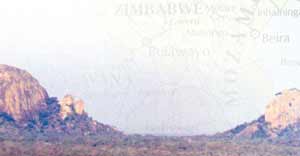
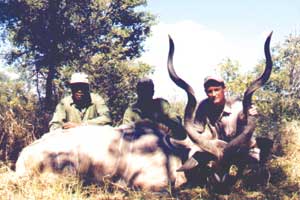
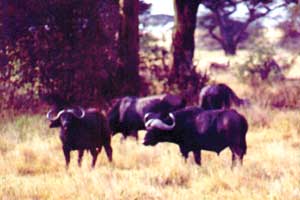
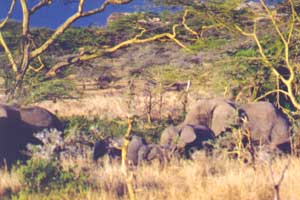
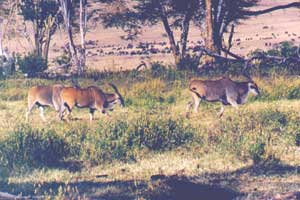
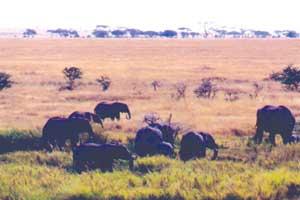
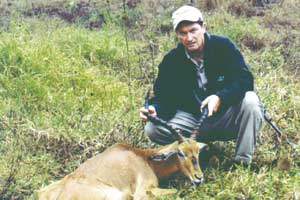 After six days of hunting kudu, I thought my luck would surely change.
I was getting decidedly anxious and trying not to let it affect
concentration, which was difficult after such a good but unproductive
stalk this morning. We had left camp at the usual time, just as light
was getting strong enough to see. Less than a mile from camp, while
driving to the area for the day’s hunt, we saw a magnificent kudu bull
of at least 55", about 100 yards into the bush. A quick conference on
the roll saw a rapid change of plans. We parked the truck and the stalk commenced.
After six days of hunting kudu, I thought my luck would surely change.
I was getting decidedly anxious and trying not to let it affect
concentration, which was difficult after such a good but unproductive
stalk this morning. We had left camp at the usual time, just as light
was getting strong enough to see. Less than a mile from camp, while
driving to the area for the day’s hunt, we saw a magnificent kudu bull
of at least 55", about 100 yards into the bush. A quick conference on
the roll saw a rapid change of plans. We parked the truck and the stalk commenced.
It was never going to be easy, but when we were about 50 yards from where the bull was seen, two loud barks told us that yet again we had been sprung. There was no breeze or noise but we were made and the bull was gone in typical kudu fashion. Kudu are not known as the ‘Grey Ghost’ of the bush for nothing.
Isaac took up the spoor and off we went through the long grass and Mopane bush, wet with the morning dew. The animal was being tracked and it was easy to see he was not alarmed, as he was keeping to the clearings and moving at a steady pace.
Since we were not gaining on this bull and the trackers were confident of his direction, we split off to one side and went ‘hell for leather’ to a prominent Kopjie (a mound of bare rock usually 100 to 300 feet high with gently sloping sides) a little to the left and climbed to the top and sat down in the sun. The vista was magnificent, a light green and relatively open forest complete with clearings and with granite Kopjies all around the horizon. This is classic sweetveld country, which had once upon a time been cattle farmed. It was now totally reverted to its natural state.
Almost immediately we saw our bull through the Mopane, where he had since joined up with two immature bulls. Down we went on an intercept course when, wouldn’t you know it, I felt a puff of wind on the back of my neck, which was soon followed by the characteristic kudu bark. Sprung again. With the only shot possible being at one of the young bulls on the run, I wasn’t going to pull the trigger. At $US650 each, it would have to be a good bull.
There was nothing to do but resume plan A and try to relax. My job was to shoot the one extra francolin required for the night’s dinner. These birds are both fun and challenging to hunt and shoot, a bit like a half-size bantam on steroids. They jump out of the cover with a flurry and fly low and fast for more cover.
On the edge of the day’s planned hunting area, there were many more francolin but all thoughts were again on kudu and almost on cue, a good bull was sighted feeding along at their usual quick pace.
Off we stalked and then it was down on hands and knees, crawling through the long grass. Having seen a mamba and a puff adder in the preceding days, this was about as exciting as it gets - but for all the wrong reasons. I was glad when our bull was seen moving stage left and I could get up from snake level. Back we went but we could not see him and then suddenly there he was, about 150 yards behind us. Isaac whistled and he turned, presenting a frontal shot that took him cleanly. What a head and what a sense of elation. I had collected the plains game ‘holy grail’. As usual, the Landcruiser was brought in through the bush and the whole animal winched aboard for butchery back at camp. Absolutely nothing is wasted here.
My week in Zimbabwe, the first week of nearly four weeks in Africa, had started with my arrival into Bulawayo from Auckland via Sydney and Johannesburg, where John Sharp Safaris met me and whisked me through customs and to the hanger housing his six-seat Piper. An hour and a half later we were landing at Malangani where I was to spend the next week hunting.
After dropping my gear into the thatch and stone bungalow that was to be home for the next week, it was time to sight in the borrowed Remington .375 H&H. My handloads, 270-grain Hornadys over 4064 powder, shot higher in this lighter rifle than in my custom Mauser (left at home because of political uncertainty and extensive African travel plans) but the Federal 300-grain Nosler partitions did the trick. After 20 rounds over the bench, my shoulder was really pleased. John said, “Put three in the rifle and let’s go for a hunt.”
We saw lots of game in that last hour of light - buffalo, impala, waterbuck, warthogs, baboons and an enormous kudu bull. A stalk was attempted but the kudu barked twice and disappeared. Little did I know that was to be a common experience throughout the next six days. Back to camp for a few cold beers around the campfire. Watching the sunset over the lake on my first night in Africa was pure magic and I was absolutely exhausted. Dinner was wildebeest back steak and South African red wine - about as good as it gets.
Shaka, the houseboy, woke me at 5.30am with a hot cup of tea in bed, then it was over to the main building for breakfast. We climbed aboard the Landcruiser and headed out to the day’s hunting area. The team consisted of Isaac the head tracker; Andre, a trainee PH; John the PH and Kevin the junior tracker, who replaced a tracker that had retired to look after his new (extra) wife. A couple of years ago he had married a woman much younger than himself, who in quick order found a suitor closer to her own age and they eventually ran off together. He complained bitterly to his father-in-law and was promptly given his 13-year-old daughter as his new wife. Yes, Africa is different; it would never catch on here.
The day’s events were to be the pattern for the next seven days. The weather was fine and cool; the cold Castle beers were great, as was the Mopane campfire, which burns much hotter than manuka. Shaka told me that when the wood sparks, that is where a snake has crawled over the wood. The sunsets were an amazing sight. It is easy to see why people get hooked on Africa; it is the essence of life and death.
Game was everywhere in this area, almost certainly as a result of its economic value and the protection accorded it here. Poachers are shot on sight. During the past five years 17 were shot, five fatally.
We were stalking kudu and impala but without success. The ‘goway’ bird was a constant frustration; the moment the animals hear its ‘goway’ call, they know humans are around and decamp promptly. Still on day two, a successful stalk was made on a bachelor group of impala, with a .375 doing the job easily. Needless to say, the 300-grain Nosler went end-to-end and on towards South Africa.
The team all thought I had missed, but the animal was stone dead and they all relaxed. Clearly I had proved that I could shoot. Seems that not all visiting hunters can. You are very much on trial for the first few days - quite the opposite of the solo hunting that is the norm in New Zealand.
While driving back to camp a good kudu bull and his cows were seen in the Mopane and a stalk ensued. Through the excellent Swarovski scope, a cow was seen standing directly in front but no shot was possible. In all I stalked four bulls that day, with no shot being taken for one reason or another. Eland and zebra were noticeable by their absence, which John assured me was unusual.
We headed to the top of a very big Kopjie. Using their 20x eyes, Isaac and Kevin saw a herd of zebra off in the distance. When pointed out to me, I could just see them through my 10x binos. These guys have absolutely amazing tracking abilities and eyesight.
An hour later we had stalked close to the zebra and lined up one through the Swarovski scope. The animal seemed to turn square on as the effect of the stripes took effect and, as a consequence, the bullet took him through the back of the lungs. We waited a bit before following up the herd but there was no dead animal and the herd moved off with no wounded animals in it. The herd was calling to the missing animal so it was onto the back trail. Kevin found where it had turned off. Fifty yards further on was a very dead zebra. What a relief after an anxious wait.
By day four I had settled down and was really enjoying myself and trying to absorb all of the different sights and sounds. For some reason we never encountered much game that day. The animals were particularly scarce in the northern area, which is close to a native village. Finally, late in the day we got onto a good kudu bull that was feeding. After a reasonable stalk, I managed to get the rifle onto the sticks but John suggested I wait to be sure the horns were good. When he confirmed that they were indeed worthy, the shot was impossible because the rapidly lowering sun was now full into the scope. The Africans don’t like shooting after 5 o’clock, as it makes any tracking and follow up difficult, especially on dangerous game.
Day six turned out to be the red-letter day, having successfully taken my kudu bull, the plains game ‘holy grail’. It was good to have an afternoon in camp and to be able to catch up on my diary and generally kick back with a few beers. The next day was when the travelling really began. We had to journey back to Bulawayo by road because there was a problem with the aircraft. It was then onwards through Harare to Nairobi for the weekend and then into the Serengeti by 4x4 truck - but that’s another story.
There is a lot of hunting in Africa and it is possibly the second-biggest industry - it certainly is in Zimbabwe, where close to 60,000 people are employed either directly or indirectly throughout the country, which earns nearly $US60 million per annum. It would be very easy to expand the New Zealand hunting industry onto public lands; all it needs is a change in government policy and for the animals, those on public lands, to be given status as game animals and thus economic value. Hunting in New Zealand will have to be paid for in the future, one way or another. Our egalitarian society has largely now gone.
New Zealand’s biodiversity is being constantly modified and we can’t turn the clock back to some mystical situation that Twig & Tweet or the ‘Greens’ think existed a long time ago, nor can the outdoors be locked up for the benefit of such groups. It belongs to us all and hunting will not go away; it is one of man’s primary instincts and is a growing industry worldwide. Sadly for many, a visit to the local mall is about as exciting as it gets.
If you love hunting, go to Africa. It will open your eyes to game management, socialism and true conservation. But most of all Africa and its hunting and wildlife are truly wonderful.
